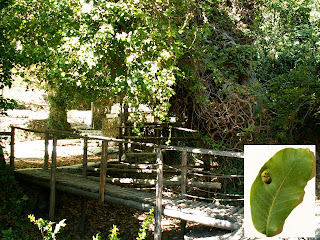After last weeks detour to The Dew ponds of Katharo
we’ll continue our journey up the valley, crossing the tarmac road that cuts
across the hills between the villages of Agios Ioannes and Schninokapsala and
head into the woods behind the church of St. George of Psychro.
 |
| Walnut Leaf Gall Mite, Aceria erinoea |
As you can see there are plenty of deciduous trees
here and if you can tear yourself away from picking up the walnuts on the floor
for a moment there’s a little example of life here that’s worthy of our
attention. You see this blister on the walnut leaf? That was caused by a Walnut
Leaf Gall Mite. These microscopic creatures feed upon the leaf and secretions
within their saliva cause the leaf’s growth hormones to go into overdrive. There’s
no evidence that this does much harm to the tree other than cosmetic and it
certainly won’t affect your nuts so you can stop looking at them suspiciously.
Let’s cross this little seating area where they
celebrate St. Georges day on April 23rd and make our way up the path
towards the church. You check that little outbuilding for bats and rats; I
think I’ve just spotted something on this Oleander leaf. I thought it was; it’s
a Leafhopper Assassin Bug. You may recall (see Red Autumn) that these New World Bugs turned up in Europe in
2011 and that we were the first to observe them in Crete down at our base camp
in Ferma. That was five kilometres away and over five hundred metres lower down
so they certainly appear to be spreading. We’d better make a note of that. Both
the bug and the plant are non-native species and there may be a connection so
we’ll record that too.
This looks like a good place to cut off the path
and make our way into the woods. There’s some more wild Oleander here which
shows that we’re in a stream bed (although you’ll commonly find them planted by
roadsides) but they can tolerate both winter floods and summer droughts so this
is just right for them. Terribly toxic to us humans of course but the bugs seem
to love it. This little one is our local seed bug, as it were; Lygaeus creticus, and you’ll often find
them in association with Oleander. As the shrubs extend along the riverbed the
length of the valley they form a sort of highway. It could be that the
Leafhopper Assassin bug is using this highway too which is why it’s important
to record not only what we see and where and when but also what we find them
on.
I can hear running water ahead and you know that’s
like a magnet to me. Here we are, these are the Springs of Psychro which supply
Ierapetra and the villages to the east with our drinking water. Let’s take a
sample to check for microscopic life. Meanwhile there’s a plant that you may
recognise from your house or garden, it’s a Black Maidenhair Fern. Here it is
in its natural setting, growing on limestone in a damp, shady place. This looks
about as far as we can go in this direction so let’s retrace our steps to the
church and see if we can spy out the next part of our route.
What a fantastic view from up here and it seems as
if we’ve reached the head of the valley. Any further progress looks as though
it would involve some serious climbing. So, where to next? Well, just to our
left, beyond that ridge there is another valley that climbs even higher but a
bit more sedately so I suggest that we make for there next week and when we’ve
reached the top we’ll turn around and walk back down to the sea along that valley.
What a beautiful day to finish this part of our journey, do you hear that high
pitched peeping call? The Spotted Flycatchers are back giving us one of the
sounds of autumn. As Pa Larkin used to say, “Perfick”.
News Update
| Common Ivy, Hedera helix |
A couple of weeks ago I
said that the ivy would soon be in flower. Would I lie to you? It’s in flower
now.
Pleasingly, but not
surprisingly, the water sample from the Springs of Psychro showed no signs of
microscopic life up to a magnification of six hundred times. Nice to prove to ourselves that our tap water is safe to drink.
Thanks for your “looking
forward to the book” comments on various social media sites. I’m collecting
them to show to prospective publishers.
***********************************************************************************
LINKS:
Naturalists
(the facebook page that accompanies this blog)
(search - people-stevedaniels-observations)
Visit Greece (National Government Tourist
Office)






No comments:
Post a Comment